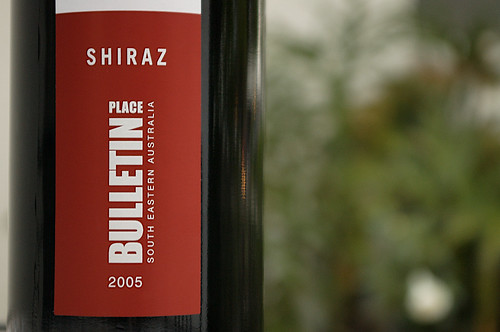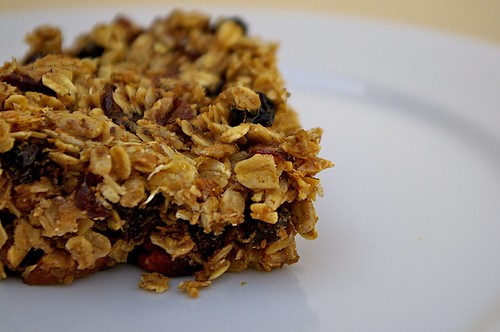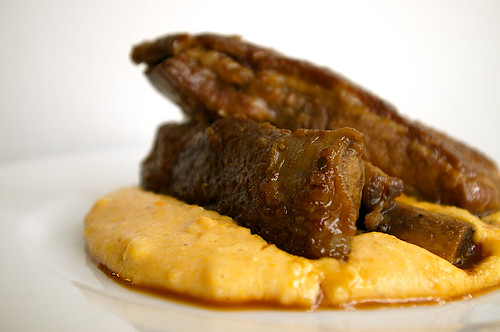This is the second post in an irregular series of blog entries about the value cooking can bring to our lives. The first is about clutter and how it can affect our thinking.
I hope to convince more people to cook. I've learned a lot by cooking: about food, the environment, and myself.
Since I began to cook seriously, I've started looking at time in a different manner. I tend to think of processes as simultaneous. I know what I can get done while the shrimp sautés, the pasta water boils, or the ribs braise (Hint: You can do a lot while the ribs braise). Anyway, I began thinking about cooking in relation to the current productivity groundswell among geeks, knowledge workers and creatives and firmly believe that all of us should learn to cook (even thought leaders).
What's in it for me?
First, knowing how to cook makes people want to have sex with you. It's true. Ask around. People dig people who know how to cook. After all, if the zombies attack and the world goes to shit, your fave sushi place isn't going to be delivering. It's a survivability issue. Knowing how to cook well also is one of those party tricks you can pull to amaze your friends. I love when someone says they have no food in the house, but I can find butter and flour and milk. Pasta, mushrooms, salt, pepper and olives and can whip up a simple, rustic, Italian-style dish that's worthy of a pretty good wine. They're stunned at what can be done with a few leftovers and solid cooking fundamentals. And lighting your farts on fire or burping the alphabet can only carry you so far.
The real value of cooking, however, lies in consistency, preparation and time management. Take a burger and fries, for example. For this seemingly simple meal, you have to get the grill hot, prep the ground beef, cook the burgers, toast the buns, slice the vegetables, cut the potatoes (peel them first, if you want to go that way), fry the fries, fry them again (the secret to crispy fries is double frying), allow time for them to drain, and bring it all together on the plate at the same time. That's a lot to do and a lot to keep straight.
So How's it done? Think ubiquitous capture, and instead of next actions, think simultaneous processing.
Mise en place
The phrase "mise en place" is a French term meaning "establishment." We're not talking about The Man here, or something against which you should rail. No, we're talking about ubiquitous capture--about gathering information--collecting your requisite ingredients--and making sure you have things prepped so you can do what you need to do. For a presentation, this might mean your notes, some key bullet points and a selection of images. Or at least membership in a good, online photo library. For an article it might mean research notes, additional contacts, your laptop, pencils and the requisite Moleskine. For our burger and fries example, you'll also need some things:
- 2 pounds ground beef
- 2 tablespoons worcestershire sauce
- 2 large garlic cloves
- 2 teaspoons of kosher salt
- 2 large sweet potatoes
- (the recipe works for other normal potatoes. I like yukon gold for their high starch content)
- buns
- romaine lettuce
- A large fresh tomato (if the tomatoes aren't fresh, do without)
- Mustard, ketchup, mayonnaise, and any other condiments you might want
You'll want to have waiting in the wings:
A heavy pot, enough oil to give you a couple inches worth in the bottom of said pot, a serving bowl for fries, and plates for the burgers.
Let's also up the complexity and say you want to serve milkshakes. We'll keep it simple--vanilla--but you'll still need to have the drink prepped and ready to go when it's time to sit at the table. For that you'll need milk and ice cream (preferably whole milk and premium ice cream). And in the wings? Your blender.
All in all it seems pretty simple, right? You get everything out of the fridge and start making your burgers. But wait! Beef should be allowed to come up to temperature to enable more even cooking. You don't want your lettuce to wilt at the edges while it languishes for a plate. Now what do you do?
Contextual cooking and simultaneous processes
You have to think of each piece in relation to all others, and you have to think about what you can accomplish while other processes are running their course. You have no other choice. If it's time to plate and you don't have the tomatoes sliced, the burgers are going to ruin the buns with grease. There are stop-gap measures, sure. You can coat each bun with a thin layer of mayo to create a water barrier (which you should probably do anyway), but even that won't hold forever. So begin to ask yourself, What's going to take the longest amount of time and require the lowest level of maintenance?
The Grill
Let's assume you're doing the right thing and use real hardwood charcoal. You're looking at maybe 40 minutes for the grill to fully heat, and we want the burgers to be ready to hit the grill when the grill's ready for them. If the grill cools, we're screwed.
It's only going to take about five minutes to crush and slice the garlic, add the worcestershire sauce and mix the ground beef, so we've got 35 minutes to do nothing, right? Not so much. You'll want to mix the burger ingredients and mold your burger patties while the meat is cold, so it's easier to handle. But then you want the burger patties to come close to room temperature before you grill them, so you can ensure even cooking. So figure five minutes prep time, another five minutes making the patties--we're looking for 6 to 8. You'll want to form palm-sized balls and then flatten to approximately 1/2 inches thick. Make sure, too, to make a small depression in the middle of each patty as they tend to bulge during cooking. We're at 10 minutes. Then we want the patties to sit for about 20 minutes--for a total of 30 minutes prep time for the burgers. So why not take the first 10 minutes to peel and cut the potatoes into fry sized pieces? Now we've got a solid 40 minutes with nary a moment wasted.
Check it out:

- Light grill
- Peel and cut potatoes (10 min)
- Mix burger ingredients in a large bowl and form patties (10 minutes)
- Let the burgers come to room temperature (20 minutes)
- Grill is now hot and ready (40 minutes)
What to do during the 20 minutes of cool-down time? Clean. Seriously. The last thing you want to do is face a mountain of dirty dishes after you've gorged on burgers and fries. We all know the shakes won't last long, and you'll end up moving to beer. And then there's television, and pretty soon the night's over and you're standing in the yard with your pants around your ankles swearing to god you can point out the Pleiades. No one's going to do dishes after that fiasco.
Begin heating the oil over medium-high heat. Then spend 10 minutes washing up the bowl you used to mix the ground beef and the next 5 minutes getting together the things you're going to need to make French fries: large deep pan, vegetable or canola oil, salt. Regulate your heat and take a deep breath.
The roller coaster crest
Now things get a little tricky. You know that moment when the roller coaster crests the first hill--all slow clicking up to that point, a moment of silence, and then all hell breaks loose and everyone's arms-in-the-air and whooping and hollering as the coaster rushes through corners and loops? Things get kind of like that now. Think of it as your deadline.
The burgers are going to cook for about four minutes on each side--maybe less, depending on thickness. You can't be running in and out this whole time. What you'll want to do is put the burgers on the grill. While they cook on side one, go back inside and get a plate and sheets of tin foil. Since nearly all meat dishes need to rest before you serve them, the burgers get to sit a bit, which will give you time to complete the fries and milk shake. Now go back outside and flip those burgers.
Once you've flipped the burgers to side two, go back inside and get your drain pan for the fries--a cookie sheet lined with paper towels and topped with a cooling rack, and bust out the blender. Set the ice cream and milk next to the blender. Now head back outside and get the burgers off the grill. You should put them on a plate and cover them with foil.
The process for fries is simple. You drop them in hot oil (approx 350F), get them out, increase the oil's heat, and drop them in again. The cooking time is about four minutes total (2*2), but with the fetching and dropping and draining, the whole process can take 10 minutes, which is perfect. Now all you have to do is keep up with yourself!
- Drop the fries in the oil, start the timer
- Turn on your oven's broiler
- Measure milk and ice cream into the blender--two scoops for each half-glass of milk
- Take the fries out of the oil and set them on the cooling rack
- Pulse the shake mixture, set the blender's carafe in the fridge
- Drop the fries back into the oil
- Slice the tomato and rip the lettuce
- Get the fries out of the oil, onto the cooling rack
- Place the buns in the oven under the broiler
- Lberally slat the fries and move them to a bowl lined with wax paper or paper towels
- Pull the buns from the oven
- Plate and take the burgers to the table
- Use the bowl of fries as a center piece, family style
- And pour those delicious shakes
Dinner is served and wonderful.
Ok. Now I can make a burger and fries. So what?
Recipes rarely talk about serving more than a single item. If they do, it's often some small accountrement, like parmesan crisps to go with your cauliflower soup (delicious, by the way). And it's because cooking a meal and making sure everything is done at the same time is tough. Broken out into its component parts and the time required for each takes a lot of words. The skill and temperament necessary to handle it is valuable, though, and will provide you a sense of calm under pressure and enable you think differently and more productively about time, no matter the task at hand.
 Fry holder for your car:
Fry holder for your car:








